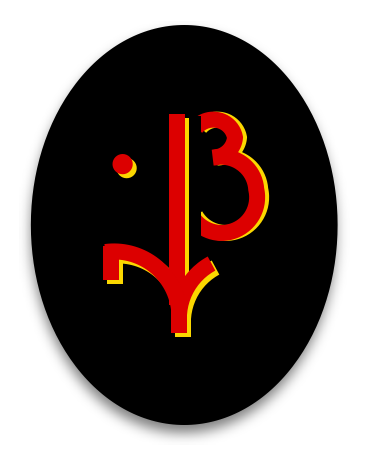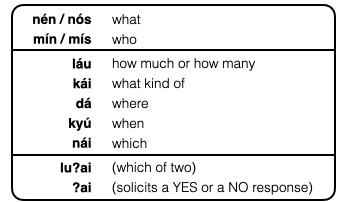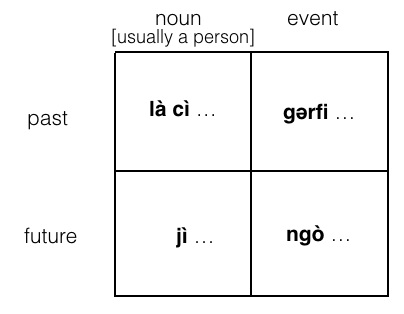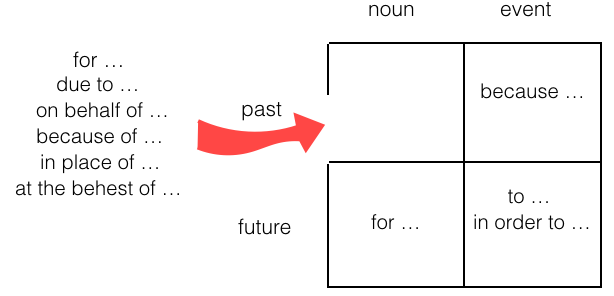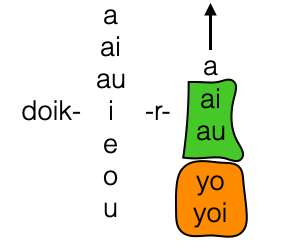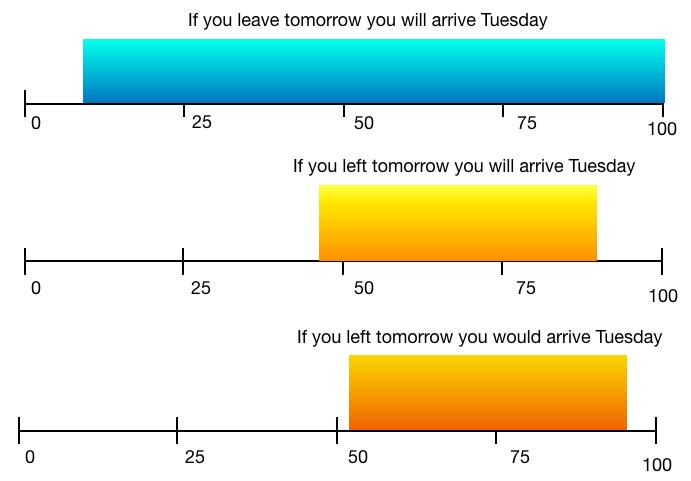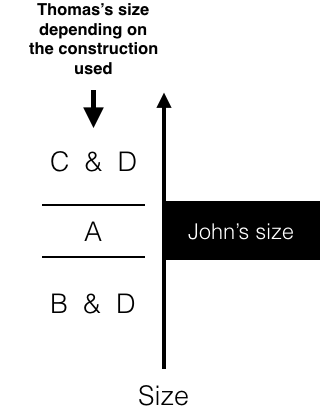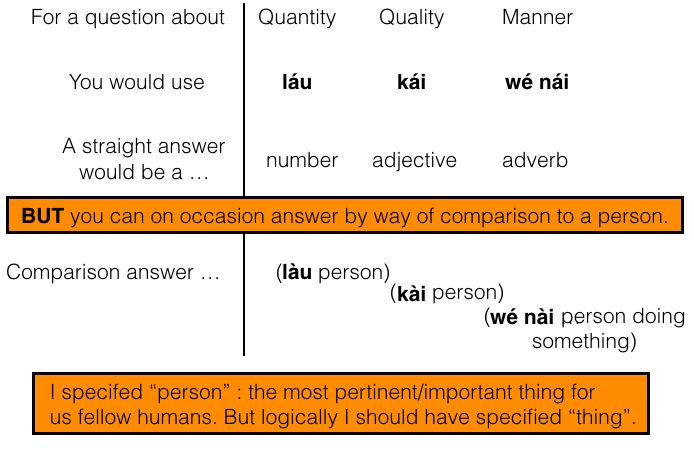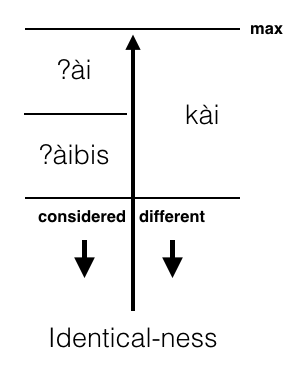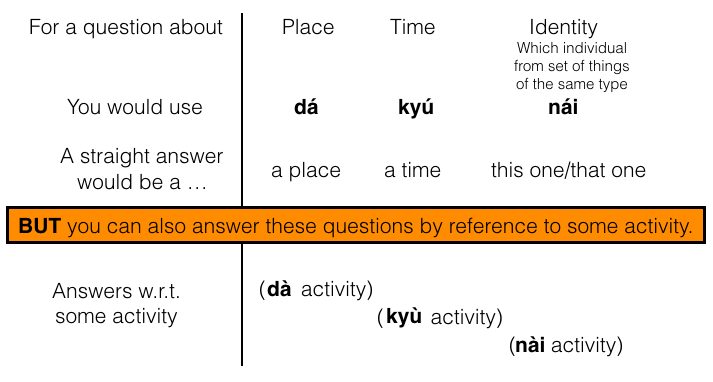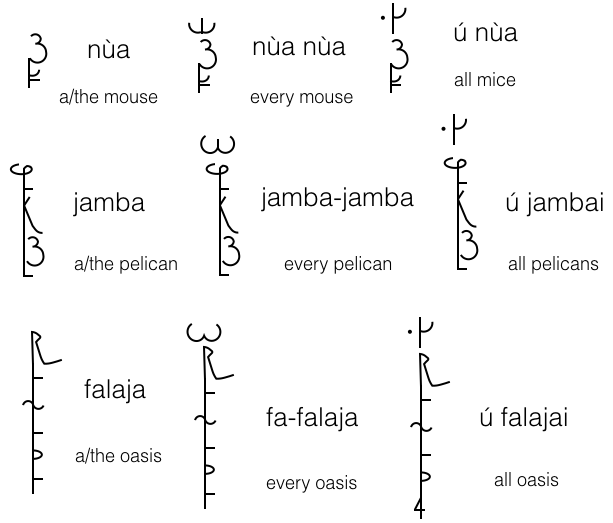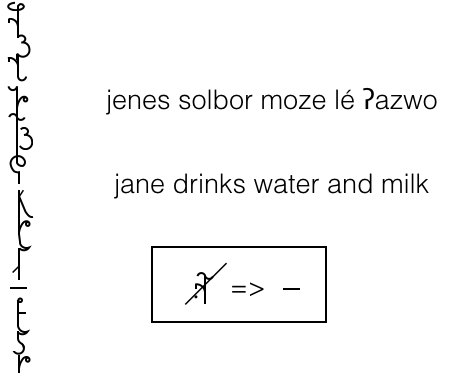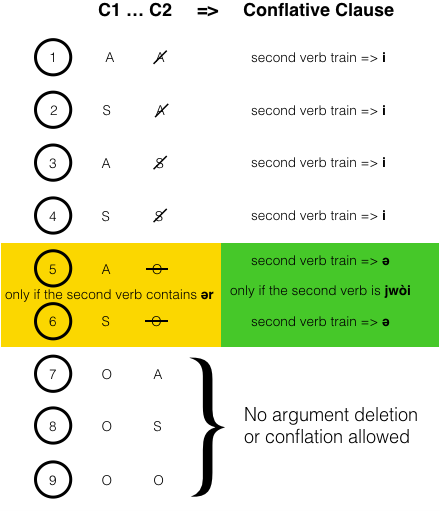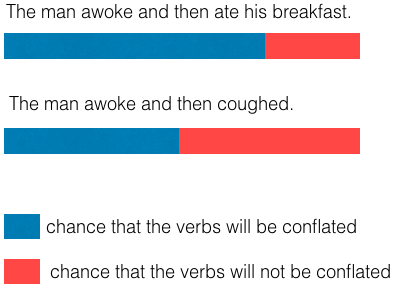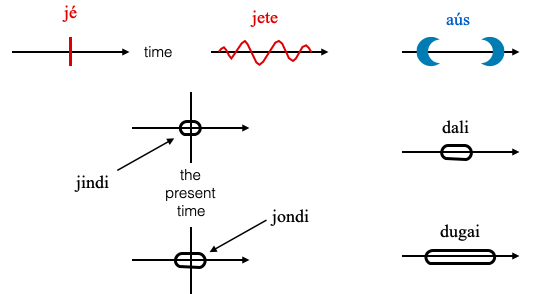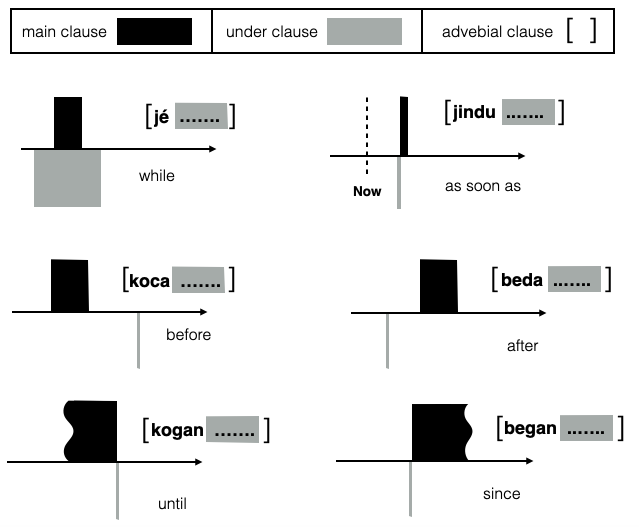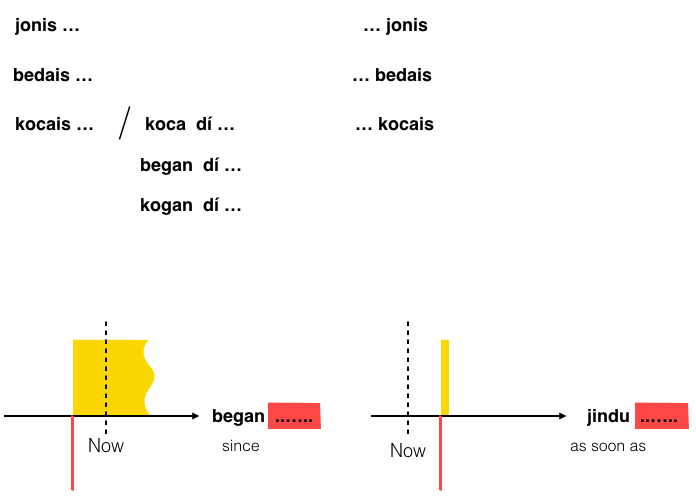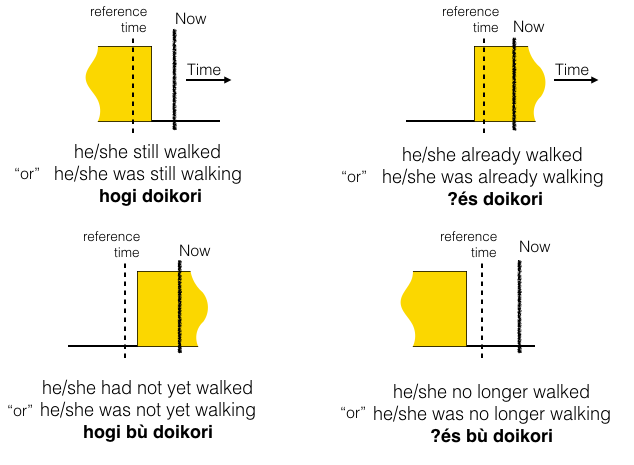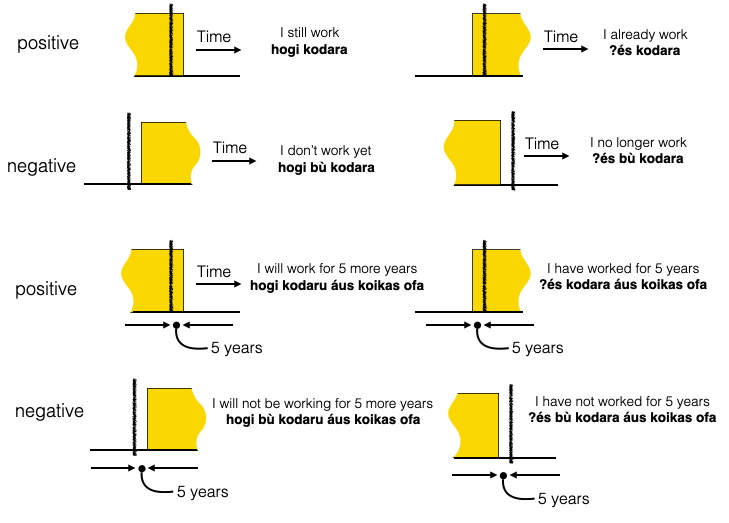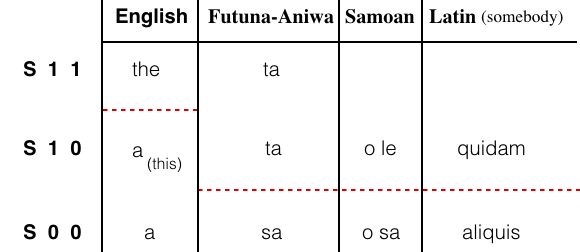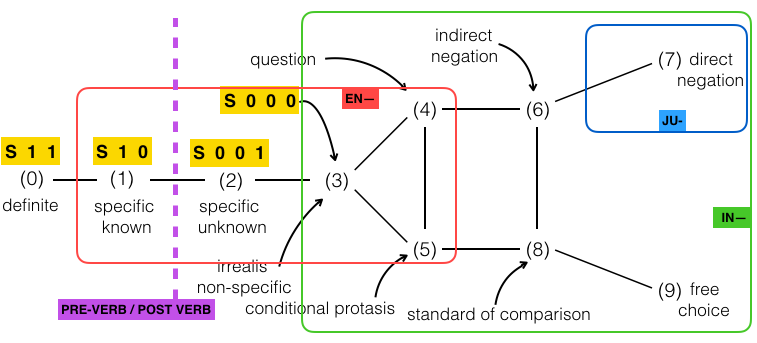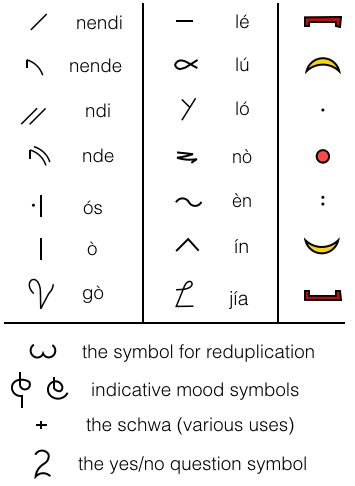Béu : Chapter 5 : Questions
..... Seven generic nouns
..
There are seven generic nouns in béu. Actually there meaning is so general that they don't have that much meaning content. For example if you hear nèn "thing" ... you know what is being referred to doesn't belong to one of the other six generic categories, but that is about all that nèn tells you.
Note that the first two have an irregular ergative ... nòs and mìs.
..
| nèn, nòs | thing |
| mìn, mìs | person |
| làu | amount |
| kài | kind, type |
| dà | place |
| kyù | time, occasion |
| sài | reason |
..
Because the above are so lacking in information content that they are frequently used for unknowns. For example ... you have a situation (a clause) but one component of that situation is either unknown* or is awkward to express for some reason. When used in this fashion, the generic noun is always fronted.
SOME EXAMPLES
Now there are two interesting particles in béu ... ?ó and kò. The latter is used for requesting a material thing, the former for requesting information. So ...
?ó = "tell me"
kò = "give me"
Only used for first person singular and the here and now. For anything other than the first person singular and the here and now, the suppletion forms XXXX and YYYY are used.
It can be seen that ?ó plus one of the "algebraic" clauses I talked about above, are questions.
EXAMPLE, EXAMPLE, EXAMPLE
In fact there is an altenative set of question forms.
..
| ?ó nèn, ?ó nòs | what | nén, nós |
| ?ó mìn, ?ó mìs | who | mín, mís |
| ?ó làu | how much | láu |
| ?ó kài | what kind of | kái |
| ?ó dà | where | dá |
| ?ó kyù | when | kyú |
| ?ó sài | why | sái |
..
The two forms are in complementary distribution. The longer form tends to be used if the question is a new topic of conversation. The shorter version tends to be used when the question is part of an established conversation. But if you mix this up, nobody feels you are murdering the language. The longer form is also used anytime you want to give the question more emphasis.
..
Mention YES/NO questions !!!
These 7 particles do not take nài to form a relative clause. That is why I classify them as particles as opposed to normal nouns.
EXAMPLE
..
* A bit like in Algebra. Maybe you first come across "x" in an equation such as "2(x+3)=10". I posit this equation is an analogy of the situation (clause) I referred to above. Where one component is unknown. Initially it is necessary to refer to the unknown by using the other elements in the clause. ( Perhaps) later the unknown can be identified uniquely.
..
..... Questions questions
..
English is quite typical of languages in general and has 8 question words ... "which", "what", "who", "whose", "where", "when", "how" and "why". *
..
..
If you hear any of these words you know you are being solicited for some information. These words have no other function apart from asking questions.
..
Notice that there is no word for "how" or "why" in the above table. These are expressed by wé nái and nenji** respectively.
On the other hand, béu has single words where English has "how much" and "what kind of".
..
The first two have dual forms ... nén and mín are the absolutive forms and nós and mís are the ergative forms.
..
Now ʔai? always comes utterance final ... ʔala always comes between two NP's. This leaves 7 QW's. Of these nén mín dá and kyú are fronted***. láu is sometimes fronted.
And láu kái dá and nái **** are found in their respective slots within a NP ... 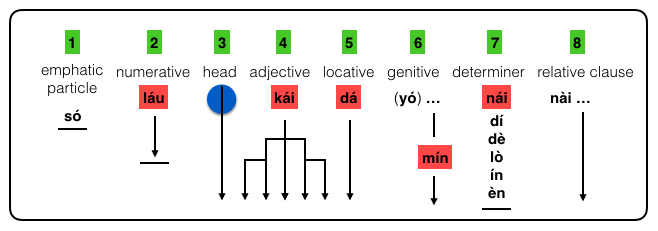
Note that when questioning who owns something yó mín occurs within the NP ... this is a sort of secondary usuage of mín and is not considered here.
Also note that dá can be either fronted or within a NP. When fronted it asked where the action takes place. When within a NP it asks about the NP's location. For example ...
..
| jene-s | halma | dá | hump-o-r-u |
|---|---|---|---|
| Jane- ERG | apple | where | eat-3SG-IND-FUT |
=> where is the apple that Jane will eat
A suitable answer to the above is pazbala "on the table"
| dá | jene-s | halma | hump-o-r-u |
|---|---|---|---|
| where | Jane- ERG | apple | eat-3SG-IND-FUT |
=> where will Jane eat the apple
A suitable answer to the above is pazba?e "at the table"
láu is an interesting QW. When you expect an integer answer between 1 and 1727 ... "láu senko" are fronted. Otherwise "senko láu", "olus láu" or "saidau láu" are in situ.
[Note to self : I need some examples of the above]
..
Statement .... bàus glán nori alha = the man gave the woman flowers
Question 1 .... mís glán nori alha = who gave the woman flowers ?
Question 2 .... minin bàus nori alha = the man gave flowers to who ?
Question 3 .... nén bàus glán nori = what did the man give the woman ?
Question 4 ... bàus glán nori láu alha = How many flowers did the man gave the woman ?
Question 5 ... bàus glán nori alha kái = What kind of flowers did the man give the woman ?
Question 6 ... dá bàus glán nori alha = Where did the man give the woman flowers ?
Question 7 ... kyú bàus glán nori alha = When did the man give the woman flowers ?
Question 8 ... í glá nái bàus nori alha = to which woman did the man gave the flowers ?
Question 9 .... há bàu nái glán nori alha = which man gave the woman flowers ?
Question 10 .... bàus glán nori alha ʔala cokolate = Did the man gave the woman flowers or chocolate ?
Question 11 ... ʔír doika ʔala jaŋka = Do you want to walk or run
Question 12 .... bàus glán nori alha ʔai? = Did the man gave the woman flowers ?
Question 13 ... minji bàus glán nori alha = Why did the man give the woman flowers ?
..
*Note ... there was also a "whom" until quite recently. Also some people count "whose" as a separate QW ... however it shouldn't be ... it is just "who" + "z" (the genitive clitic).
**Well nenji is the normal traslation of "why". In certain situations you might hear minji ... when it is knows that an action/state is for somebody's benefit and no other reason is applicable.
***Around one third of the world's languages front a question word. English is one of them. [ see http://wals.info/feature/93A#2/25.5/151.2 ]
****Actually these 4 words often stand alone. But when they do, they are still considered within a NP ... only that the rest of the NP has been dropped.
..
THE BELOW SHOULD GO TO A SECTION ABOUT QUESTIONS
With a more complex NP it is usual to break it up in order to specify exactly which element is being questioned. For example ...
bawa gèu tiji láu pobomau nài doikura = " How many little green men on the mountain that are walking? "
bawa gèu tiji láu nài doikura _ láu r pobomau
wò bàu gèu pobomau nài doikura _ láu r tiji
wò bawa gèu tiji pobomau _ láu doikura = w.r.t. the little green men on top of the mountain, how many are walking ? ... or ...
wò bàu tiji pobomau nài doikura _ láu r gèu = w.r.t. the little men on top of the mountain who are walking, how many are green ?
THE ABOVE SHOULD GO TO A SECTION ABOUT QUESTIONS
In the table of question words above I have marked the top two and the bottom two off. The top two because they are the QW's par excellence ... they are used more than the other QW's. The bottem two because their answers are restricted to two items. ?a is restricted to "yes" or "no" ... ?ala to one of the NP's that sandwich it.
láu kái dá kyú and nái each have low tone equivalents. These particles are important grammatical words in their own right and they each are related to their high tone equivalent in subtle ways. Basically làu introduces the "partitive construction" , kài means "like" or "similar", dà introduces an adverbial phrase of location, kyù introduces an adverbial phrase of time, and, nài is a "relativizor".
..
..... Why oh why
..
"Why" is nenji in béu. Obviously derived from nén and the jì (the pila?o). "Why" is asking for what reason an event/state came about. The answer to nenji can by said to comform to one of the four scenario's shown below.
..
..
gərfi and ngò are followed by a clause. là cì and jì are followed by a noun (usually a persons name).
..
gərfi is used when the questioned event/state was caused by an event/state in the past. That is the questioned event/state is a consequence of an event/state in the past.
ngò is used when the questioned event/state exists to facility some event/state that is envisaged in the future.
là cì is used when the person following là cì (or at least a some supporter/collaborator of hs/her) has requested the questioned event/state at a previous time. cì = matter/affair
jì is used when the subject of the questioned event decided to do something for the benefit of the person following jì. The subject is the initiator of the action in this case. The benefits of the action are likely to materialize at a future time.
..
..
..... The conditional sentence
..
These two modifiers ... yo and yoi are basically the equivalent to the Swahili NGE tense and the Swahili NGALI tense.
..
..
Basically yo represents an "open" conditional sentence, and yoi represents a counterfactual conditional sentence. Evidentials are never used with yo and yoi.
..
Remember from CH4 (more verb modifiers) that the verb modifier -ai can be equivalent to "when" in English. For example ...
tìa pirai_ maumare = When you entered the house, I was asleep.
This can also be expressed as ...
kyù tìa pire_maumare
..
Conditional sentences are for making plans, for considering contingencies.
In English ... "if you go, they will kill you" ... two clauses ... the first introduced by "if" .... "if (A), (B)".
Sometimes "then" can introduce the second clause [ "if (A), then (B)"] but this is not considered essential in English. However some natlangs require a particle in front of the second clause. In Chinese the particle 就 jiù is needed.
..
kyù jiru / gì dainuru => "when you go, they will kill you"
| kyù | j-i-r-u | / | gì | dain-u-r-u |
|---|---|---|---|---|
| when | go-2SG-IND-FUT | "pause" | you | kill-3PL-IND-FUT |
..
tà jiryo / gì dainuryo => "if you go, they will kill you"
| tà | j-i-r-yo | / | gì | dain-u-r-yo |
|---|---|---|---|---|
| if | go-2SG-IND-COND | "pause" | you | kill-3PL-IND-CON |
..
dà jiryoi / gì dainuryoi => "if you would go, they would kill you"
| dà | j-i-r-yoi | / | gì | dain-u-r-yoi |
|---|---|---|---|---|
| if | go-2SG-IND-CF/COND | "pause" | you | kill-3PL-IND-CK/COND |
Note ... dà jiru is a place ... "where you will go"
..
You will see that béu has a nice symmetrical system when it comes to counterfactuality.
This is different from English, which has quite a lopsided system ...
The blue reflects a plain "if" conditional. The 15% to the left would be expressed with "when" rather than "if".
Now the plain "if" conditional can be used in situations with wildly different truth values.
However if you want to be more specific as to truth value, you would use one of the orange constructions above. These constructions are a bit messy ... past tense => counterfactual : pluperfect => past tense + counterfactual. Plus none of the above represent 100% counterfactuality. If one of the orange constructions above represented 100% counterfactuality, then a tag such as "but you won't leave tomorrow" would be ungrmmatical. So the English system is a mess (although naturalistic).
..
Note ... In béu the sequence yi is not allowed. And while the sequence ye is allowed it never occurs in the conditional marker. So how does béu express a conditional sentence in which one or both clauses is set in the past. Well you must use ryo plus an adverb. An adverb such as "this morning", "yesterday", "in the past", etc. etc.
Oh ... and one final thing. In béu (as in English) the consequent can precede the antecedent. This is a bit unusual. Joseph Greenberg’s Universal 14 says … “In conditional statements, the conditional clause precedes the conclusion as the normal order in all languages.” (Greenberg 1966: 84; Greenberg 1990: 49) Greenberg states that “the antecedent almost invariably precedes the consequent in the unmarked, or only permissible case …. " I believe the following languages are strictly antecedent first … Turkish, Mongolian, Tamil, Korean, Chinese, Japanese
EXTRA ... Because of the distribution of "if" + "past tense" (its range quite far towards the LHS), it is possible to cancel* "if" + "past tense" conditional sentence. For example "If you had enough money, you could visit Australia", could be cancelled by adding "... well you have enough money, you can visit Australia". This sort of cancellation can not be used with "da" [the LHS of "da" would have to spread a lot further to the RHS to make it cancelable].
..
..... Six important particles
..
Namely làu jía kài "wé nài" ?ài and ?aibis
..
wé and nài are particles in their own right but the combination "wé nài" is more than the sum of its parts (or perhaps "is more than the product of its parts" is more appropriate). Hence "wé nài" should be considered a separate particle made up of two words.
..
... làu
..
There are 3 main uses for làu
..
1] The first use is when we are using the extended number set. làu stands between the noun (senko or olus) and the extended number ...
..
3,05112 elephants => sadu làu uba wú odaija
| sadu | làu | uba | wú | odaija |
|---|---|---|---|---|
| elephant | "partitive particle" | 3 | 123 | 51 |
..
Note ... the singular form of senko always used when quantity is given by this method.
We have already touched on this in the previous chapter [ see the section Numbers ... (the extended set) ].
I call làu a partitive particle when it is doing this function.
To the left of làu, the noun always has a generic meaning hence in this position it would never take the kai prefix. [ cf. sadu = elephant : kaizadu = elephant-kind, "the elephant as a species" ]
So *kaisadu làu uba wú odaija is illegal.
This construction is often seen with "magnifier" duplication ...
sadu làu wú wú = thousands of elephants : sadu làu nàin nàin = millions of elephants : sadu làu hungu hungu = billions of elephants
When specifying an amount of an olus, làu is use with any number, not just an extended number ...
..
Two cups of hot milk => ʔazwo pona làu hói hoŋko
| ?azwo | pona | làu | hói | hoŋko |
|---|---|---|---|---|
| milk | hot | "partitive particle" | 2 | cup |
..
Two baskets of peaches => pice làu hói kapu
| pice | làu | hói | kapu |
|---|---|---|---|
| peaches | "partitive particle" | 2 | basket |
..
pice is in fact olus. A single peach would be picai. By the way, if the basket was more pertinent than the peaches you could say ... kapu picia <= kapu pic-ia <= "basket peaches-having"
..
2] I also call làu a partitive particle when it is doing its second function ...
..
Three of these doctors => moltai.a dí làu léu
| moltai.a | dí | làu | léu |
|---|---|---|---|
| doctors | this | "partitive particle" | 3 |
..
Note ... the plural form of senko is always used for this construction.
..
Two cups of this hot milk => ʔazwo pona dí làu hói hoŋko
| ?azwo | pona | dí | làu | hói | hoŋko |
|---|---|---|---|---|---|
| milk | hot | this | "partitive particle" | 2 | cup |
..
Of course, for an olus there is no plural form.
This second function of làu is when we are taking a portion from a larger amount. The first function of làu is when we are taking a portion of X out of the sum total of all the X in the universe.
For the olus, there is not so much difference between function 1) and function 2).
..
3] I call làu a quantitative particle when it is doing this function. Here is a typical example of làu functioning as a quantitative particle ...
..
tomo r jutu làu jono => "Thomas is as big as John"
..
The construction is ... "copula adjective làu noun" as opposed to English "AS adjective AS noun"
In the negative it is ... "bù copula adjective làu noun" as opposed to English "not SO adjective AS noun" ... (By the way ..." not AS adjective AS noun" is also valid in English)
..
In béu the final noun can be replaced by a clause introduced by gò. For example ...
Thomas is so clever that he doesn't have to go to school => tomo r jini làu gò bù byór jò banhain
| tomo | r | jini | làu | gò | bù | by-ó-r | jò | banhai-n |
|---|---|---|---|---|---|---|---|---|
| thomas | is | clever | "equalitative particle" | that | not | have-3SG-IND | go | school-DAT |
..
Now as copula + adjective is more or less equivalent to "verb" so the following is included here ...
Thomas thinks as fast as John => tomo wòr saco làu jono
as the same construction type.
..
We have talked about what I call the quantitative particle above. This is used when two nouns, verb to the same degree. But how you describe a situation when we have "more" or "less" degree ?
I think this is a suitable time to go into this.
Taking the last example, we get ...
Thomas thinks faster than John => tomo wòr yú sacois jonowo
with more degree.
Notice the lack of làu, the adverbial suffix -is and the suffix -wo on the noun.
For less degree we have ...
Thomas thinks not so fast than John => tomo wòr wì sacois jonowo
..
And for the copula adjective constructions with "more" or "less" degree. This paradigm is shown below ...
..
Question ... tomo r jutu láu => "how big is Thomas ?"
Answer[A] .... tomo r jutu làu jono => "Thomas is as big as John"
Answer[B] .... tomo r wì jutu jonowo => "Thomas is less big than John"
Answer[C] .... tomo r yú jutu jonowo => "Thomas is bigger than John"
Answer[D] .... tomo bù r jutu làu jono => "Thomas is not as big as John"
Notice that D, invariably in English, makes Thomas smaller than John. Not so in béu. A B and C tend to be used a lot more than D.
[Note to self : get rid of -ge ? .... use it only in NP ? an alternative to C ? ]
Two more examples ... just for fun.
| jono-s | huz-o-r | làu | kulno |
|---|---|---|---|
| john-ERG | smoke-3SG-IND | like | chimney |
=> John smokes like a chimney
..
| taud-o-r-a | làu | hunwu | huakod-ia |
|---|---|---|---|
| to be annoyed-3SG-IND-PRES | like/as | bear | headache-having |
=> he/she is annoyed like a bear with a sore head
..
... jía
..
jía has two functions.
..
Also it has two shorthand forms ... the only word in the language to be so honoured. The leftmost word is never used. The => character used for the second function. The remaining character used for the first function.
..
1) In most languages you can drop certain components if they are obvious from context. And when you do the remaining utterance stays unchanged. However béu does not work like that*. We saw in the previous section that the particles used to show cause/reason are different, depending upon whether they are followed by a simple noun or by a clause. The same happens when we are making a statement by way of comparison. For example ...
..
Thomas thinks as fast as John => tomo wòr saco làu jono
Now obviously "John thinks" is underlying here. However if you want to make "John thinks" overt you must change làu to jía ...
Thomas thinks as fast as John thinks => tomo wòr saco jía jono wòr
Notice that English patterns the same way for both the above examples.
..
2) In English we have the verb "to equal" ... it bit of a strange verb. Almost exclusively found in a mathematical setting. (The adjective "equal" has the same form as the verb "to equal" .. but anyway ... )
The béu particle jía is used in most situations where we find the English verb "to equal". In a setting such as 2+3=5 ... well there are no need for tense or aspect ... we are talking about a timeless truth. Also no need for person affixes ... the elements (arguments) involved are always stated the the left and the right of jía. Also no need for evidential markers ... the world of béu considers evidentials as appropriate for the human world ... but the world of mathematics is so far beyond the human world ... to have evidentials on a mathematical expression would be to drag the matheverse down into the dirt. Hence jía is an invarient particle. By the way jiagan = "equation".
..
* Now why have I set things up like this ... well in béu it is quite easy to define a clause. A clause is a chunk that contains one active verb (active verb = a verb having an "r" ). I guess I have set things up like this, so as to firmly draw a line between one clause constructions and two clause construction.
[ Note to self : why DO you want it like this ?]
..
... kài and wé nài
..
There are 6 main uses for kài.
..
1] In this first function it is equivalent to "like" or "similar to" in English.
..
| jono | r | kài | dada | òn |
|---|---|---|---|---|
| john | is | like | older brother | his |
=> John is like his older brother
..
2] Sometimes kài can best be translated as "made of" ...
a/the wooden house => tìa kài wuda
the house is made of wood => tìa r kài wuda
..
3] Sometimes kài can best be translated as "for" ...
water for drinking => moze kài solbe
water for washing clothes => moze kài laudo
this water is for washing clothing => moze dí r kài laudo
(in the above three examples, kài and what follows it can be considerd an adjective)
..
4) In the fifth function kài actually merges with a following senko ...
elephant = sadu
elephant-kind = kaizadu
this is actually a noun, the idea being something like "that which is like an elephant"
[ Note ... it is interesting that the béu word for "species" is kaija. Probably from " kài aja ", aja being an obsolete word for "one". ]
..
5) In its sixth function kài actually merges with a following saidau ...
red = hìa
reddish = kaihia
..
6) And the sixth function ...
..
| gì | r | gombuʒi | kài | jono |
|---|---|---|---|---|
| you | are | argumentative | like | John |
=> you are argumentative like John .............................. i.e. in the same manner ... for example ... shouting over other people when they try and put forward their arguments
..
This only is applicable to "complicated "adjectives ... adjectives that like have internal structure. I find it difficult to imagine a situation where this construction would be suitable for an adjective like "short".
I see "short" as a one dimensional adjective while I see gombuʒi as a multifaceted adjective.
You are treating gombuʒi ss one dimensional when you say ...
..
| gì | r | gombuʒi | làu | jono |
|---|---|---|---|---|
| you | are | argumentative | like | John |
=> you are as argumentative like John ...........................i.e. to the same degree
..
In the above to examples, I would call kài a "qualitative particle", and I would call làu a "quantitative particle".
..
Now as "copula + adjective" is more or less equivalent to "verb" so the following is included here ...
..
| jono-s | klud-o-r | kài | tomo |
|---|---|---|---|
| john-ERG | writes-3SG-IND | like/as | thomas |
=> John writes like Thomas writes
..
In most languages you can drop certain components if they are obvious from context. And when you do the remaining utterance stays unchanged. However béu does not work like that. We saw in the previous section that the particles used to show amount by way of comparison are different, depending upon whether they are followed by a simple noun or by a clause. The same happens when we are making a statement about manner by way of comparison. For example ...
..
Now in the above example, it is obvious that "thomas writes" but "writes" has been dropped. If we want to make this "writes" covert we must change the particle.
..
| jono-s | klud-o-r | wé nài | tomo-s | klud-o-r |
|---|---|---|---|---|
| john-ERG | writes-3SG-IND | "in the manner that" | thomas | writes-3SG-IND |
=> John writes like Thomas writes
Note ... when the final verb is dropped, the ergative marking on tomo is also dropped.
..
làu and kài sometimes gets mixed up. For example in the following example kài might actually get used more often than làu. While làu might be correct "logically", kài is more felicitous for savouring the rich imagery of "a fish out of water".
Perhaps if béu was a spoken language kài might take over from làu in many situations.
..
| bù | ?oim-o-r-a | làu | sainyi | moz-ua |
|---|---|---|---|---|
| not | to be happy-3SG-IND-PRES | like/as | fish | water-lacking |
=> he/she is unhappy like a fish out of water
..
This chart below might be of interest ...
..
..
It shows how three question words correspond to three low tone particles.
..
..
One more example ... just for fun.
| tomo-s | futuba | lent-o-r | kài | yuzebi.o |
|---|---|---|---|---|
| thomas-ERG | football | play-3SG-IND | like | Eusabio |
=> Thomas plays football like Eusabio ............................................................ i.e. attacking the goal directly, strong on the ball with a powerful shot
..
... ?ài and aibis
..
These are mention here because they overlap with the first function of kài
These particles plus the noun (or NP) they qualifies are equivalent to adjectives.
?ài is derived from ?à "one". There are quite a number of adjectives derived from nouns by the suffixing of -i ... (the meanings of these derived adjectives are often on the quirky side).
[ Note ... the English word "same" < P.I.E. "sem" meaning "one" ]
?aibis is formed from ?ài plus the suffix -bis meaning "tending to".
?ài and ?aibis overlap in meaning with kài when in the first of its six functions.
We can say ... kài = "like"/"similar to" : ?ài = "identical to"/"the same as" : ?aibis = "a bit like"/"similar to"
You use ?ài or ?aibis if you want to specify the amout of similarity, use kài if you want to leave this vague.
Other related words/expressions are ... ?aiko = to equalize : sàu ?ài = to be equal : bù ʔài = "different" : sàu bù ?ài = "to differ"/"to be different" ?aiti = similarity (one feature) : kuwai ?ài = similarity (in general) : u?aiti = difference (one feature) : kuwai u?ai = difference (in general) ?aiwe = to agree
..
Examples of ?ài usage ...
..
1) jono lé jene sùr ʔài (bèn) = "John and Jane are the same" ... logically the bèn is unnecessary, but it is often included for euphony .... (bèn is used about 97% of the time in this construction)
2) jono r ʔài jene = "John is the same as Jane"
The above two examples are ambiguous as to whether John and Jane are the same w.r.t. one characteristic or the same w.r.t. all characteristic. It should be known from context. If not you can disambiguate by ...
A) jono r ʔài jene jutuwo = "John is the same size as Jane"
B) jono r ʔài jene uwe = "John is the same as Jane in every way"
C) jono lé jene sùr ʔài (bèn) jutuwo = "John and Jane are the same size" .... (bèn is used about 50% of the time in this construction)
D) jono lé jene sùr ʔài (bèn) uwe = "John and Jane are the same in every way" .... (bèn is used about 50% of the time in this construction)
..
Note that (A) can also be expressed as jono r jutu làu jene ... see the third fuction of làu.
For comparison of ability to do something ...
jono r bòi làu jene kludauwo = "John is as good at writing as Jane"
[Note to self : sort out ... how to say "a similarity" ? ... "a difference" ? ]
[Note to self : sort out ... ʔài dù = exactly the same ? ... ʔaimai = similarity ... lomai = difference ]
..
..... Two verb prefixes
..
Earlier we saw how jwòi could be used to make a passive. That is, it took a transitive verb, detransitivized it, and made the original O argument the S argument [the original A argument having fi suffixed and becomes a side argument]
béu also has a means to take a transitive verb, detransitivized it, and made the original A argument the S argument [the original O argument having h suffixed and becomes a side argument]
This process involves prefixing li- to the verb. For example ...
jonos jene timpori => jono litimpori (jeneh)
This process has been given the unfortunate name ... "anti-passive".
Some of the world's languages which are reckoned to have "anti-passives" undergo a semantic change when the anti-passive operation is applied. [Something like "I shot at the bear" compared to "I shot the bear" in the active voice. This does not happen in béu. In béu the li- prefixing operation only shuffles argument around.
However there is a prefix that signals non-success. This prefix is ?eu-. Actually "non-success" is not quite correct. ?eu- means "what was meant to be achieved by 'verbing' was not, or was not fully achieved".
Actually I think there is only four verbs where what is meant to be achieved is fixed ...
| try | => | succeed |
| look | => | see |
| listen | => | hear |
| hear* | => | understand |
In some cases, what people are attempting is nearly 100% predictable. For instance, if it was the hunting season and a hunter said "I ?eushot the deer" you could not be far off, if you took that to mean "I shot at the deer meaning to kill it but I missed"
In many cases what is meant to be achieved is totally dependent on background information which is not obvious to everybody. For example ... if it was known that hilda was going to the school to enroll her child for the following year. Then if you heard hilda say ?eujari schoolh ... you would know she went to the school but was unsuccessful in her mission. But perhaps only two or three people would know the background story.
Some times this prefix can be used to comic effect.
..
*"to hear someone speak" to be more exact
..
..... Two noun prefixes
..
huwu = good thoughts
huwu.ai = a good thought
hugu = good deeds
hugu.ai = a good deed
?igu = bad deeds
..
hu- has provenance in avestian [cognate of Sanskrit su-]. ?i has provenance in Thai อี.
..
..... Stuff to sort
..
Usually for particles that can either be followed by a NP or a clause, I add gò after the particle when a clause follows. This is to prevent errors in comprehention. For example jì means "for" and is followed by a NP (usually a person). I have jì gò meaning "in order that" ... jì gò being followed by a clause. In béu the first word of a clause is often a noun. If I had jì meaning "in order that" there might be misunderstanding (albeit temporary). English does this also in many constructions [ I should go into this more fully ??? ]. Of course I could have a totally different particle for "in order that" but I wanted to emphasis the semantic overlap between these to constructions.
There are 4 nouns that are associated with 4 of these above question word / indefinite pairs. làus = amount, quantity : kàin = kind, sort, type : dàs = place : kyùs accasion, time.
These 4 nouns are never followed by nài. The table below is interesting. It shows the logical equivalence of a hypothetical expession (on the LHS) and the logical equivalent actually used (on the RHS).
..
*làus nài => làu
*kàin nài => kài
*dàs nài => dà
*kyùs nài => kyù
..
There are two adjectives associated with these question word / particle pairs. laubo meaning "enough" and kaibo meaning "suitable".
Also there are two nouns associated with these question word / particle pairs. lauja meaning "level" and kaija meaning "species/model".
..
?ode r jutu làu sadu = "they're as big as an elephant" (talking about elephants in general) : ?ode r jutu làu sadu dí = "they're as big as the elephant"
..
Good, Better, Best
..
| >>> | boimo | best |
| > | boige | better |
| = | làu bòi | as good |
| < | boizo jige bòi | less good |
| <<< | boizmo | least good jimo bòi |
..
The top and the bottom items are the superlative degree and so have no "standard of comparison".
The fourth one down is used less frequently than the second one down. This is because its sentiment is sometimes expressed by negating the third one down. For example ...
gì bù r làu bòi pawo = "you're not as good as me" can be used instead of gì r boizo pawo "you are less good than me"
[ actually gì r boizo pawo would be the normal way to express this sentiment. But gì bù r làu bòi pawo would be used, for example, as a retort to "I'm as good as you" ]
The superlative forms are found as nouns more often than as adjectives. That is boimo and boizmo are rarer than boimos and boizmos. (see table below)
..
boimos = the best : bàu boimo = the best man
boizmos = the least good : bàu boizmo = the least good man
..
... Three important particles
..
... dà
..
dà = where
pà twahu dà yildos twaire = meet me where we met in the morning ........................ dà yildos twaire can be considered an adverb of place.
..
... kyù
..
kyù = when
toili gìn naru kyù twairu = I will give you the book when we meet ............................ kyù twairu can be considered an adverb of time.
..
... nài
..
In English "who", "that" and "which" are relativizors ... a particle that introduced a relative clause. For example ...
"The man who ate the chicken"
"The chicken that was eaten"
"The knife and fork which were used to eat the chicken"
..
In béu there is only one relativizer, which is nài. For example ...
glá nài bàu timpori = "The woman who the man hit"
Now ... in the above ... glá is being modified by nài bàu timpori. nài bàu timpori implies a clause bàu timpori glà.
To construct a relative clause for glá, nài is inserted between the noun and clause, and the noun is dropped from the clause.
Now in the above example ... the roll of glá in the clause is absolutive (i.e. glá is unmarked). However if the roll of the noun ... in the clause ... is one defined by one of the 17 pila?o, this pila?o must be suffixed to nài. For example ...
..
pi ... the basket naipi the cat shat was cleaned by John.
la ... the chair naila you are sitting was built by my grandfather.
... mau / goi / ce / dua / bene / komo ...
tu ... báu naitu òn is going to market is her husband = the man with which she is going to town is her husband ... kli.o naitu he severed the branch is rusty
ji ... The old woman naiji I deliver the newspaper, has died.
-s ... báu nàis timpori glá_rò jutu sowe = The man that hit the woman is very big.
wo ... The boy naiwo they are all talking, has gone to New Zealand.
hn ... the woman nàih I told the secret, took it to her grave.
fi ... the town naifi she has come is the biggest south of the mountain.
ni ... tìa naini she lives is the biggest in town = the house in which she lives is the biggest in town
-lya ... the boat nailya she has just entered is unsound
-lfe ... the lilly pad nailfe the frog jumped was the biggest in the pond ... (note to self : improve this, work out translation for all these concepts)
..
If the roll of the noun (in the clause) is one not specificated by the 17 pila?o then the noun can not be dropped entirely, it must be represented by a pronoun. For example ...
| gwài | nài | polg-u-r-a | fía | ?ode |
|---|---|---|---|---|
| the islands | REL | sail-1PL-IND-PRES | between | them |
Literally "the islands that we are sailing between them" ... or ... in good English ... "the islands that we are sailing between"
| gawa | nài | toti-s | lent-o-r-e | tài | ʃide |
|---|---|---|---|---|---|
| the women | REL | children-ERG | play-3SG-IND-PAST | in front of | them |
Literally "the women that the children played in front of them" ... or ... in good English ... "the women that the children played in front of"
..
| há | gawa | nài | toto-s | lent-o-r-e | tài | ʃide | waudo | dainuru |
|---|---|---|---|---|---|---|---|---|
| ERG | the women | REL | children-ERG | play-3SG-IND-PAST | in front of | them | dog | kill-3PL-IND-FUT |
Literally "the women that the children played in front of them, will kill the dog" ... or ... in good English ... "the women that the children played in front of will kill the dog"
..
In English we have what is called a headless relative clause. béu has this also ...
nài hecair rò nài mair = "what you see is what you get"
nàis hecor rò nàis mair = "that which sees is that which gets"
òn nàis hecor rò òn nàis mor = 'he that sees is he that gets" ... [this one not headless of course ... a pronoun has been added to narrow down what exactly we are talking about]
..
..
... Totality ... collectively or individually
..
Sometimes we want to talk about all members of the category "noun" acting (or being acted upon) COLLECTIVELY.
For this we use the particle ú before the plural of the noun. For example ...
moltai = a/the doctor
moltai.a = doctors
ú moltai = all doctors
Note ... the same word, when appended to a noun, means "the whole" or "entire". For example ...
goize ú = all morning
..
The opposite of the above is when all members of the category "noun" is acting (or is being acted upon) INDIVIDUALLY.
By doubling the noun (or the first part of a noun) you give what can be called a distributive meaning.
Some examples ...
nùa = a/the mouse
nùa nùa = every mouse
jamba = a/the pelican
jamba jamba = each pelican
falaja = oasis
fa-falaja = every oasis
Notice that for words over two syllables, only the initial consonant and following vowel/diphthong is prefixed.
..
..
The "word-hood" of these duplications is murky. When the word in its entirety is dublicated, they are written as to seperate words. When a word is only partially duplicated I write it as a hyphenated word. In the béu script a special symbol is used to indicate duplication.
Single syllable words retain their tone when duplicated ... which indicates two separate words. However you also get phonological processes that are usually only word internal. That is to say, these structures show some "sandhi".
For example ...
yildos yildos (every storehouse) would be pronounced / yildoʃ yildos /. If this was two seperate words it would be pronounced / yildos yildos /. If this was one word it would be pronounced / yildoʒyildos /
bàu bàu can be pronounced bàu vàu ... [ If you remember ( Chapter 1.1) b and v are in free variation ]
là bàu bàu = "on every man" .... indicates that bàu bàu is multi-word as the pila?o is in its stand alone form.
fa-falaja?e = "at every oasis" .... indicates that fa-falaja is a single word as the pila?o is appended.
Anyway ... these constructions are never written out in full. Instead a special symbol is placed above the simple noun. This symbol can vary a bit, depending on the font being used : it can vary from a lower half circle bisected by a vertical stroke to a shape that looks a bit like the Arabic shaddah.
For example ...
..
It some contexts, semantically, it does not matter whether the individual or the collective form is used. When this is the case, the default choice is "individual" structure. ú tends to be used with tangible nouns more, it is hardly ever used with nouns denoting periods of time.
Note (as in English) the plural verb form is used for the collective structure, the singular verb form for the individual structure. For example ...
ú bàu súr = all men are
bàu bàu sór = every man is
NOTE TO MYSELF
Every language has a word corresponding to "every" (or "each", same same) and a word corresponding to "all". "all" emphasises the unity of the action (especially when the NP is S or A) while "every" emphasises the separateness of the actions. Now it is not always necessary to make this distinction (perhaps in most cases). It seems to me, that in that case, English uses "every" as the default case (the Scandinavian languages use "all" as the default ??? ). In béu the default is "all" ù.
The meaning of this word (in English anyway) seems particularly prone to picking up other elements (for the sake of emphasis) with a corresponding lost of power for the basic word when it occurs alone. (From Etymonline EVERY = early 13c., contraction of Old English æfre ælc "each of a group," literally "ever each" (Chaucer's everich), from each with ever added for emphasis. The word still is felt to want emphasis; as in Modern English every last ..., every single ..., etc.)----
TO THINK ABOUT
?à ?à bàu hù ?ís = any man that you want ( ?ís ... "you would want" ???? )
?ài ?ài bàu hù ?ís = any men that you want
?ài bàu = some men
..
... And for a verb ... many many iterations
..
As duplication has (a very iconic) function with nouns, it has also a function with verbs (and very iconic too ... if I may say so)
..
| jò | to go | jojo | to scatter, emit |
| té | to come | tete | to gather, collect |
| pyá | to stop off | pyapya | to stutter (person or engine) |
| dàu | to die | daudau | to fade away |
| nda | to put | ndanda | to dump |
| mài | get, receive | maimai | to rely on |
| náu | give | naunau | to support |
| pila | to put | pipila | to arrange |
| timpa | to hit | titimpa | to beat |
| yáu | to have | yauyau | to have in abundance |
| ?ái | to want | ?ai?ai | to be greedy |
| lí | to press | lili | to crowd, to throng |
| tí | to touch | titi | to fondle, to caress |
| jwòi | to undergo | jwoijwoi | to be taken advantage of, to be a victim |
| ?áu | to take | ?au?au | to strip something bare |
..
pila "to place something correctly and orientate correctly" : pipila "to arrange", "to tidy up", "put in order" .... jenes pazba pipilaru = Jane will arrange the table ... a room, a house, [any place], an institution
Also ... look.look = inspect : listen.listen = to sound out (a group of people) : talk.talk = to try and sell an idea (to an individual, but more commonly, to a group of people)
..
... lé .... lú .... ló
..
Earlier we have seen that when 2 nouns come together the second one qualifies the first.
However this is only true when the words have no pilana affixed to them. If you have two contiguous nouns suffixed by the same pilana then they are both considered to contribute equally to the sentence roll specified. For example ...
jonos jenes solbur moze = "John and Jane drink water"
In the absence of an affixed pilana, to show that two nouns contribute equally to a sentence (instead of the second one qualifying the first) the particle lé should be placed between them. For example ...
jenes solbori moʒi lé ʔazwo = "Jane drank water and milk"
jonos jenes hecuri hói sadu lé léu ʔusfa = John and Jane saw two elephants and three giraffes.
[ Compare the above two examples to á jono jene solbori moze = Jane's John drank water ... i.e. The John that is in a relationship with Jane, drank water ]
This word is that is never written out in full but has its own symbol. See below ...
..
Note ... in the béu script, the "o" before "r" is always dropped. This is just a sort of short hand thing.
..
The following construction is also found.
lé moze lé ʔazwo = "both water and milk"
The above construction emphasizes the "linking" word lé
Another linking word is lú meaning "or".
jenes blor solbe moze lú ʔazwo = "Jane can drink water or milk"
The following construction is also found.
lú moze lú ʔazwo = "either water or milk"
The above construction emphasizes the "linking" word lú
There is another word that corresponds to the English "or". This is lu?o and it is a question word. For example ...
ʔís moze lu?o ʔazwo = "would you want water or milk"
And the answer expected of would be either "water" or "milk"
Say you were asking somebody if they were thirsty and you had only water or milk to give them. Then you would say ... ʔís moze lú ʔazwo ʔai@
The expected answer to the above question would be either "yes" or "no" (as is always the case when you have @ ( @ is pronouced a bit like ʔai but has contour tone instead of a normal high tone, it has a special symbol and I am using "@" to represent this symbol in my transliteration)).
Now if the question was "would you want water or milk, or both" you should say ...
ʔi?o moze lu?o ʔazwo lu?o leume
But sometimes (either because of the laziness of the speaker or because the likelyhood was not considered) ... ʔi?o moze lu?o ʔazwo lu?o iman comes out as ʔi?o moze lu?o ʔazwo.
So ʔarwo iman (I would like both) is an acceptable answer to the question ʔirwo moze lu?o ʔazwo
If the questioner would like to rule out the answer ʔís leume he would use the construction .
[ Maybe just forget about having a QW for "which of these two ]
ʔís ʔala moze ʔala ʔazwo
So ʔala before the first item does exactly the same as lé or lú before the first item : it emphasizes the linking word.
..
... "no"
..
In béu, jù corresponds to "no".
"neither water nor milk" would be translated as jù moʒi jù ʔazwo
..
... lists
..
So far we have restricted ourselves to two items. We can summarize the system for two items as below ...
..
| lé | giving | 2 | items | |||||
| lú | giving | 1 | item | ..... | lu?o | asking for | 1 | item |
| jù | giving | 0 | items |
..
However we can join up more than two items. When more than two items are joined by the above 4 linking words, it is considered good style to have the linking word before the first item and the last item, before each item (except the first and the last) should be a slight pause (I call it a gap ... see "punctuation and page layout" earlier on this page).
For example ...
jenes hecori lé sadu ima _ ʔusfa uya _ moŋgo eja lé gaifai ofa falaja dí = Jane saw two elephants, three giraffes, four gibbons and five flamengos this morning.
..
... other
..
ló = other
lói = others .... mmmh, same as probably
kyulo = an other time
tugis = again
welo = otherwise
..
... Making it flow
..
Grammar provides ways to make the stream of words coming out a speaker's mouth nice and smooth ... no lumpy bits.
Getting rid of the lumps entails dropping the elements that are already known ... these elements that are already uppermost in the mind. (De-lumping also involves inserting words that efficiently link to these elements that are already uppermost in the mind ... this will be covered in the section called "Linking Back")
This section omits anaphora and is about dropping known elements ... both arguments and person-tense markers. (However anaphora and all types of dropping involve a similar mental process)
A sentence [utterance = ???] is made up of one or more clauses [r-blocks]. Two r-blocks are separated by è or another particle. é is the most common particle for joining clauses and means "and then".
In béu the particle for joining nouns and adjectives is lé
In English "he eats cheese and nuts" could be analyzed as "he eats cheese and (he eats) nuts" with the bracketed part dropped. In béu this analysis is not available. The particle between the two nouns would be lé (ar perhaps if the speaker had added "nuts" on as an afterthought ... uwe "also" would come after "nuts" (a pause before) ). The particlle è would not be used. It only separated two clauses that have dissimilar verbs.
Now in English allows the dropping of an S or A argument in a sentence when this argument has already been established as the topic. béu is pretty much the same. When two clauses are joined certain arguments are dropped from the second clause. The béu rules for dropping arguments are not atypical of the worlds languages*. The rules are given below.
..
..
In the above "C1" stands for "the first clause" and "C2" stands for "the second clause". And also in béu it is possible to integrate the two clauses further ... if the two claues share a subject and all the tense/aspect/evidential of the two verbs match, then the second verb can take its i-form (and as the definition of a béu clause is "one r-block" ... the result should be considered ONE clause. The dropping of the subject in the second clause is more or less mandatory, it would sound quite strange to retain it. As for conflating the two verbs ... well it depends how tightly bound logically the two verbs are ...
..
..
Two examples are given above. The choice between conflated and not conflated depends upon the larger body of text that these examples are embedded in. But the relative likelyhood of conflation (over all situations) is given above. It can be seen that the more predictable second verb has a greater chance of being converted into its i-form. This makes sense as more unpredictable => more information. And we do not like to put to much information in one clause.
Examples are given below ...
1) The man hit the woman and then [the man] smashed her glasses. [ there are different objects ..... can be two clauses ]
2) The man awoke and then [the man] ate his breakfast. [ this would usually be conflated ]
3) The man drank all the beer and then [the man] slept. [ this would usually be conflated ]
4) The man coughed and then [the man] went to sleep. [ maybe two clauses ... no real logical tie between the two verbs ]
5) The man hit the woman and then [the man] was spat on. ... the C2 O argument can only be dropped if the C2 A argument is irrelevant ??? [ can not be conflated ... different subject ] .... to undergo ??
6) The man woke up and then [the man] was spat on. ... the C2 O argument can only be dropped if the C2 A argument is irrelevant ??? [ can not be conflated ... different subject ] .... to undergo ??
7) The man hit the woman. Then the woman shot the man.
8) The man hit the woman. Then the woman cried.
9) The thief robbed the girl. Then the pirate raped her.
Note ... For examples 5 & 6, the dropped arguments are counted as S arguments. In béu they are considered O arguments.
Note ... For examples 5 & 6, the A argument can be supplied in a hí phrase (similarly, in English the agent can be supplied by a "by" phrase)
Dropping arguments is appropriate when the to clauses are bound together in meaning (and when bound together in meaning, by iconicity, usually on the same tone contour).
The last three cases which could not drop any arguments, are felt to be, not so tightly bound together. It is no co-incidence, that these clause pairs are often given separate tone contours ... that is ... they are separate sentences.
..
... Agents
..
kludau = to write (a verb) : kludala = writing (an adjective ... actually a participle)
Two nouns can be formed by simply adding pú in front ...
pú kludau = author, writer, novelist, playwrite, essayist : pú kludala = somebody that is writing right NOW
This is quite non-surprising. Take Thai .... เขียน khiian "to write". If you add ผู้ , คน or นัก in front, you have an agent.
[Note to self : I need a term that implies, one makes ones living from ACT]
..
daumo = pen : daumo <= kludaumo
dauno = a keyboard/typewriter : dauno <= kludauno
..
... Timewise
..
Many languages tend to use space-words to describe the time-profile of events/actions. This is understandable from a grammatical/diachronic perspective. However I consider béu to be richer, having a set of time-words totally independent from its space-words.
Hungarian has the word múlva which is the time-word equivalent to "at" (in actual practice, often represented by "in" in English ... at least when talking about the future). For example ...
haróm nap múlva jövök haza = "I'll come home in three days" ... (page 115)
The béu equivalent of "múlva" is jé.
jé = at (+ time expression) ..... represented in English by "when", "while", "during" or "as"
In theory jé indicates a point in time, a point in time infinitely short. But of course the following word determines how accurate one is being. For example ...
jaru jé jupe = "I will come in December" only pins the time of the action down to the nearest month.
To add a bit of fuzziness we can add -te "-ish" to jé. For example ...
jaru jete jupe = "I will come around about December"
To clear up a bit of ENGLISH fuzziness, people, on occasion, use the expression ú jé. How does this differ from simply jé? Well consider these two examples ...
njaru jé jupe = I will relax in December
njaru ú jé jupe = I will relax all through December
..
Other time-words are jindi and jondi**. They both mean "now". jondi is the one you usually come across. jindi can be used for emphasis (for example in a swiftly changing situation).
..
jé represents an instant in time. In contrast áus represents a span of time ... represented in English by "for". So if jé is equivalent to a point, áus is equivalent to a line. The length of this line is defined by the expression that follows áus. This length can be said to be absolute. For example ...
gayiru aús kòi ima = You will be in discomfort for two days.
Also béu has two words that define a length of time in a relative manner ... relative to what is considered normal. These words are ...
dali = a short time
dugai = a long time*
..
..
jé often locates an action/event in an absolute manner. For example when the 216 siscrete points are used to specify the time of day (go to CH7 "the time of the day" ).
But jé can also locate an action/event in an relative manner ... relative to another action/event. In the graphic below I show jé (and other time-words) doing just this.
..
..
In these examples, I have made the under clause actions very short. This is for illustration purposes only. The under clause actions can actually have any length. It depends on the verb and the situation.
Now these five examples show how two clauses can be joined in a timewise fashion. The béu rules are quite similar to English.
..
jé koca kogan beda began can introduce a clause, a noun (that designates a time) or an infinitive phrase. jindu patterns slightly different from the other five ... in that (b), the infinitive phrase, needs día "to start".
a) “After I ate breakfast”
b) “After the gold rush”
c) “After the eating of my breakfast”
Below are some examples of how jé koca kogan beda began work. I use beda to demonstrate ...
a) pintu saikaru beda pazba (saikaru) = "I will paint the door after (I will paint) the table"
a) beda pazba saikaru_pintu saikaru = "before I paint the door, I will paint the table"
c) beda saiko pazba_pás pintu saikaru*** = "after painting the table, I will paint the door"
..
..
Here are examples to illustrate the examples above ...
..
In English ... "before" and "after" are pretty much time-words. However they are related to the space-words "aft" and "fore". The two béu words for these concepts are not related to any space-words.
koca = before
beda = after
And derived from the above words we have ...
kocagan/kogan = until
bedagan/began = since
..
There is one added complication in the above scheme ... if the intersect time of the two actions is in the future, then jindu (<jín "a moment" + dù "exact") can be used instead of began.
..
..
** I guess I should say what is the difference between a main clause and an under clause. (I should read about what other linguists say about this some day). Take the sentences ...
(1) I will finish this drink before I go home. ......... (2) I will go home after I finish this drink.
In terms of pure logic these both mean exactly the same. Also the choice of whether a verb is in the main or the under clause says nothing about the speakers attidude towards that verb ... i.e. relish, disgust, foreboding, sadness etc. But is seems that the verb in the main clause is the target of the speakers determination/willpower/resolve whereas the verb in the underclause is the target of nothing. I guess you can say it is background material
..
..
*These two words give rise to two verbs ...
daliko = to hurry, to hurry up
dugako = to prolong, to draw out, to dilly-dally, to shilly-shally
dalora = he is hurrying
dugora = she is taking her time
dalihu = hurry up, come on, get the finger out
..
** These two words are related to jon and jin. jín means an interval of time an order of magnitude shorter than jón. The particle jindu is derived from it. Also they give rise to the adverbs jonis "soon" and jinis "immediately".
I guess jin and jon have meaning similar to dali and dugai. But they are used in totally different situations. dali and dugai are used to describe normal actions/events ... they are adverbs. jin and jon are more noun-like. Also they both imply short periods of time. If you want somebody to wait a minute, you usually just say jon.
..
*** this also can be expressed as ... gwò saiko pazba_pás pintu saikaru. In a similar manner pín can be used in place of jé in front of infinitive phrases. ..
Another time-word is ...
jindu = as soon as
..
a 24 hour period is divided into 6 minutes 40 seconds. These are considered "instantaneous" points. In normal day-to-day béu culture it is not considered worthwhile to have a finer graduation of time. It is like 6 minutes 40 seconds is their planck time => CH7 "the time of day"
..
..
Interesting aside ...
The organization of the Chinese writting system seems to have affected the language itself. The primary writing direction was top_to_bottom so of course the calendar was written top_to_bottom as well. From that "above" got associated with "the past" and "below got associated with "the future".
午 wǔ "noon" : 上 shàng "above" : 下 xià "under" => 上午 shàngwǔ "morning" : 下午 xiàwǔ "afternoon"
A similar thing happened in béu. The practitioners of béu are above all engineers and the algebraic convention of having time along the horizontal axis has affected the language somewhat.
Perhaps the engineering convention has not affected the language. But there is a certain "chiming together", in that the past is depicted to the left (komo), and the future to the right (bene). And of course koca is related to the concept "the past", and beda is related to the concept "the future"
..
... Linking Back
..
Now the section above shows how two clauses can be joined in a timewise manner. To do this takes a bit of working out in the mind of the speaker [of course for written language this is not a constaint. The writer has more than enough time to work out complicated patterns].
However in conversation, often things are not laid out so neatly. Consider the case where one clause has been spoken. The speaker considers himself done and gives the "finished speaking" intonation to the end of his utterance. Then ... after a split second it comes into his head that another event (clause) is also of interest to the hearer. In this case, one of the below constructions must introduce the "afterthought".
..
The s (is) suffix is the adverbial marker. And the adverbials jonis, bedais*, kocais make a connection back to the clause just spoken** ... back to the information which is still uppermost in everybody's mind [this phenomena is often called "anaphora" from the Greek "carry back"]. All the elements of the clause last enunciated are still whirring around the brain : they are easily accessible. And the words jonis, bedais and kocais connect to the "just spoken clause" [kind of like a time portal :-) ].
Now these are adverbs which must come at the periphery of the clause. Hence above I have shown the adverbs occurring clause final as well. However clause initial is the preferred location.
The dí is the proximal determiner (i.e. "this"). In béu dí is also used a lot for linking back*** to clauses just spoken. In fact dí represents the just spoken clause in its entirety.
Note that the dí constructions can only occur initially.
Now how to explain the pattern in the diagram above ? Well some believe that for an adverbial to exits, it must be quite common. That is kogan and began as afterthough introducers are quite uncommon, hence the phrases kogan dí and and began dí are used as opposed to *koganas or *beganas. Notice that koca can exist as an afterthought indroducer in the form kocais or koca dí. It is not known why the terms *jón dí and *beda dí are not allowed.
..
Now the most common way to join clauses is to use the particle è "and then". When è is used both clauses that circumscribe it are main clauses.
By the way ... when people are narrating a sequence of events (or when they are just thinking to themselves), they go through the events in the order in which they happened 9 times out of 10. It is for this reason that this section is all about "and then" and not "before that".
..
..
The above diagram shows two clauses A and B. In the normal course of events and when the speaker has the time to plan ahead, (1) would be used. If the speaker had not had time to plan ahead, one of the resumptive stategies (2), (3) or (4) can be used. dùs = "and then immediately" : diadilaIs = "eventually"" and bedais = "afterwards" as we have covered before. Now because these three adverbs can come either clause initial or clause final ... a pause "_" is mandatory. Well you would expect a pause before bedais because this is a resumptive stategy ... this is the sentence you end up with if you don't think ahead and hence fail to produce the sentence with the è "and then" particle. But dùs and diadilaIs are not resumptive strategies (at least not primarily), but a pause is insisted upon.
..
Another word that is commonly used to refer back to a recently utterance is wedi [examples 5 & 6]. It translates as "in that way".
And wede [example 7] is the cataphoric equivalent of wedi. It translates as "thus" or "like this".
wedi and wede can appear at either end of a clause, but it is more common to find them in the end of the clause nearest to the clause they refer back/forward to.
..
And yet another word that is commonly used to refer back to a recently utterance is iwe [examples 8] "anyway".
There is a word uwe that sort of counterbalances iwe. However uwe is not used for anaphora, instead it appears clause final and is a particle meaning "completely".
..
*Translating bedais unto English gives "afterwards" or "after this" or just plain "after" ... a good example of the messiness of natural languages I think.
..
**Actually a "first clause" can be absent ... these adverbs can appear after a long period of silence. In this case "the after what" refers to some action that is uppermost in everybody's mind although not recently spoken about. For example ... say you are a painter and decorator working with your helper on some sight. Now you both know that the next task will take around 15 minutes and will be a two man job. Your helper hints that he is desperate for a cigarette. To put him off for a bit, you can simply say bedais. So in this case not linking back to anything spoken ... but linking to what is uppermost in everybodies mind.
..
***Notice that English does something similar with "that". Also then ... but "then" does not represents the just spoken clause in its entirety, it only represents the time of the action.
Also in béu dè the distal determiner (i.e. "that") is used to create a link to the clause ABOUT to be spoken. For example ...
| unya | gì-n | fy-a-r-u | dè | _ | bla bla bla bla |
|---|---|---|---|---|---|
| and | 2SG-DAT | tell-1SG-IND-FUT | distal determiner | pause | "unspecified following clause" |
=> And I will tell you this, bla bla bla bla bla
Note that the béu system is the opposite of the English system.
Also note ... instances such as the above (i.e. cataphora) are a hundred times rarer than anaphora. Really insignificant.
..
... Joining clauses logically
..
Some means of linking clauses and what have you in my own conlang (just worked out). A bit complicated and a bit messy …. the same as a natlang. But I think it makes sense … also nice to have a bit of redundancy.
plà means “reason” wò is the oblique case mark, meaning “with respect to”, “about”, “concerning”
In my conlang, every single syllable word has either a low tone or a high tone. Low tone being denoted by a falling stroke (i.e. as in plà) and high tone is denoted by a rising stroke (plá means “duck billed platipus”). Multi syllable words have no tone.
plawo means “because” OR “in order to”
I was thinking about modern Swedish here. BJP was talking about “because” and “in order to” both being reduced to “för” in some modern varieties of Swedish.
When using plawo, whether it means “because” or “in order to” is usually clear from the content of the two clauses involved.
plawo is always followed by a clause (as opposed to a NP).
However “because” and “in order to” can be differentiated in my conlang. bwonafi means “because” and kyemah means “in order to”.
plawo, bwonafi and kyemah occur with about equal frequency.
Note … bwona means “cause”, kyema means “effect, aftermath, result”. -vi is the ablative case marker (i.e. “from” in English) and -h is the dative case marker (i.e. “to” in English).
There is another word that means more or less the same as kyemah. This word is “deh”. Basically, kyemah and deh are interchangeable. But maybe deh is used a bit more when the subclause represents a state rather than an action. If you wanted to emphasize “in order to” you would use the longer option. Also if you were writing poetry it would be useful to have a choice of using a single syllable word or a double syllable word. deh is more common than kyemah.
Note … de means “that”. It can also represents something about to be mentioned. And we mentioned above that -h is the dative case marker. So, deh = “in order to, so that”
Actually the purpose clause can be very tightly integrated into the main clause. Often the purpose clause just consists of the base verb. In such a case, -h is simply added to the base form. Often the purpose clause just consists of the base verb plus an object. In this case the particle hó (another form of -h) precedes the base verb.
There is another word that means more or less the same as bwonafi. This word is jìan. Basically bwonafi and jìan are interchangeable. If you wanted to emphasize “because” you would use the longer option. Also if you were writing poetry you have a choice of using a single syllable word or a treble syllable word (you can also use plawo if you need a double syllable word). jìan is more common than bwonafi.
When I started off this thread I thought there would be some similarity between “because” and “because of” in my conlang. I am a bit surprised that I have in fact ended up with totally different forms.
“because of” is yenuni. This is inspired by Norwegian and Cebuano. Let me recap …
Cebuano Norwegian English
tungod sa på grunn av because of
The Norwegian one means “on ground of” (there is an English expression, not a million miles away from this that has a very similar meaning to “because of”). In Cebuano, sa means “at”, tungod means “nadir” or “the ground directly below”.
I reckon if Norwegian and Cebuano have so close forms it must reflect a commonality of human thinking. Actually I can see the thinking/feeling behind this expression.
Note … yenu means “nadir”. -ni is the locative case marker (i.e. “at” in English).
And that is basically it, as far as “because” and “because of” go.
.. I have a little more to add to my last post. I didn’t include the data below because I didn’t want to give too much information in one post. Also “because” and “because of ” were fully covered. This post is just tying up a few loose ends.
I mentioned dèh (I think I forgot the tone mark last post), derived from the demonstative dè. There is also a particle derive from the demonstrative dí “this”. This word combines with the ablative case marker to make difi “therefore”. déh tends to be used in fluent talk. difi tends to be used when the second clause is an afterthought, it tends to be used when there is a pause between the two clauses. It also tends to be used to introduce a new line of mathematics : in a similar way that “therefore” is used in English.
Note … dí means “this”. It can also represents something just mentioned.
Lets say a bit about jìan (one syllable, we have a rising diphthongs here). The word jì by itself means “for” as in “I bought the oranges for my mother”. The word àn by itself means “that” as in “He thought that she was pretty” … I guess you could call it a nominalizer. You can imagine the meaning of these two words being twisted around a bit through time and coming together as jìan “because”. [ I do not have a fully worked out ur-lang behind my conlang, but occasionally I give some words a bit of history ].
A word not a hundred miles away from jì is cila (“c” being pronounced as “ch” in Charlie). Whareas “for” implies no happenings before the main clause verb. That is nothing really occurred before “bought” in “I bought the oranges for my mother” … it was a simple act of kindness. cila implies some happenings before the main clause verb … some “behind the scenes dealing”. So some complexity involved.
cila comes from cí meaning matter/affair and lá is the adessive case (I think) (i.e. “on” in English). lá cí => cila in a regular process sanctioned by my conlang. cila means something like “on behalf of”.
And lastly I would like to mention womih (an interesting one here). womi means “zenith” or “the highest part”. In a way, the opposite of yenu “nadir”. And as covered before, -h is the dative case marker.
womih also means “in order to”.
Now in my conculture there is a substantial body of work written which lays out a “philosophy of life” … a religion if you will. womih should only be used within this body of work. In fact it should only be used in front of the “67 noble goals”. Of course some people do not adhere to this. Some people use womih to give what they are saying a certain “flavour”. Similar to English, where some people use “thou” instead of “you”, to give what they are saying a “churchy/preachy” flavour.
Left over bits
bwona = cause ubwonwe <= ubwonawe : for no reason kyema = effect, aftermath, result ukyemwe <=ukyemawe : in vain
bwoda = origin, source
... THIS HAS TO BE COMPLETELY REDONE
..
unya = "and" (some logical connection ... well if no logical connection, the two clauses would not be appearing side by side)
tè "but"
imwa = "but"
tè ?ài kyù = "but"
??? "but" can sometimes come before nouns in English. For example ... "all but me" .... in béu' we use u?u ???
There are also some phrases with more "sound.weight" that have the exact same meaning as tè.
?? Well this is the more neutral particle (the particle plí can also be used ??
??? sé kyude/è kyude : these mean that action B follows action A but not necessarily immediate. Sometimes sé è are dropped.
??? kyugo : this means that action A and B happen at the same time. Usually we have different actors in the two clauses, but not always.
huzu = to smoke
koʔia = to cough
?acu = to sneeze
solbe = to drink
caume = medicine
Notes on grammar .... If you have two clauses, the particle must come between them : the element containing only a base verv (for example ... figo ìa saiko pazba) is not a clause. I call it a "clause adjunct" or "adverbial phrase" [I should pick one term] : for the examples above containing a clause adjunct, note that only the main clause has a subject : notice that what is marked by the perfect in English is marked by ʔès "already" in béu. In English the perfect has 3 functions ... the resultative, the experiential and the so called universal which indicates that activity has been going on for sometime and still is. In béu the perfect marker was derived from a verb meaning "finish" ... a marker derived from this source can scarcely be expected to have this "universal" function.
Also note ... cùa jì gò saiko pazba = "to leave in order to paint the table" ... In English you can drop "in order" to get "to leave to paint the table". In béu this would result in "to stop painting the table" ... never leave out jì gò.
Usually this type of clause adjunct does not express a subject ... but sometimes it can ... the subject is places after the word sàin "reason, cause, origin" and sàin comes after the object (if there is one) and the object comes after maŋga. The only element allowed to the left of maŋga is the negative jù. For example ....
timpa jene sàin jono r kéu = John's hitting of Jane was bad .... [maybe hí is better than sàin ???]
There are five particles used to introduce these time adverb phrases. Each of these particles defines a different time relationship between the main action and the under action.
Note ... Both the main action and the under action can vary considerably in length. In the above diagrams I give what I consider typical time lengths.
Note ... In English "since" can only be used for an under clause that occurs in the past. For example ...
beda jono joru_ufan rù bòi = After John goes, everything will be fine
The literal translation of the above is "since John will go, everything will be good" ... In English "since" has taken on a second meaning*. In béu, jefi has no such secondary meaning and it is perfectly to use jefi with a clause set in the future. [In the chart I specify a NOW ... this is really to signify the situation for typical usuage of the English word. The NOW is not relevant to the béu usuage]
..
*GIVE THAT EXAMPLE FROM DEUTSCHER'S BOOK.
..
The usuage of these five particles is quite straightforward. However there is one little quirk that should be pointed out. For example ...
jono liga ko?ori kogan ós solbori moze = John was coughing until he drank some water ..... ko?ia = to cough
Now the above can be recast ...
John was coughing until the drinking of water by him => jono liga ko?ori kogan solbe moze hí ò
This can be futher cut ...
John was coughing until the drinking of water => jono liga ko?ori kogan solbe moze
And further cut ...
John was coughing until drinking => jono liga ko?ori solben .... Not *jono liga ko?ori kogan solbe
When the verb-noun is only one word it will take the suffix -n instead of the particle kogan
In a similar way, when the verb-noun is only one word it will take the suffix -fi instead of the particle jefi. For example ...
John has been coughing since he smoked a cigarette => jono ko?ora jefi ós huzore ʃigita ... huzu = to smoke, to suck
John has been coughing since smoking => jono ko?ora huzufi .... Not *jono ko?ora jefi huzu
..
For beda and koca, when the time between the two events are stated ... it comes immediately after bade or koca. For example ...
beda odai yanfa jene fori = After five minutes Jane left (is féu Ø or H ?) .... [ yanfa = 5 seconds, odai = 5012 = 6010 ... so the translation is 100% accurate ]
..
..
7) jì gò = "in order that" "so" "so that"
It shows that the first action was done in order to bring about the second action/state. The particle is always between the clauses.
jonos jenen toili nori jì gò ós òn klór = John gave Jane a book in order that she would like him.
The second clause is the <purpose> of the first clause .... jonos jenen toili nori is a clause : ós òn klór is a clause : jì gò ós òn klór is an adverbial adjunct
The second clause always has the aortist tense form in this construction ... actually the gò jì makes the second verb sort of irrealis.
..
Notice that if the second clause was replaced by a NP ... jì "for" or "for the benefit of" would be the particle used.
If both clauses have the same subject, then the second one usually becomes an "infinitive adverbial adjunct", and the particle jì is used.
toili mapari jì kludau ʃila = I opened the book in order to write in it
tarye dían jì twá gì = I came here (in order) to meet you
Occasionally you can have this construction where the object of the first clause is the subject of the second clause ...
pà babas gaidoryə dían twá gì = My father brought me here to meet you
From the underlying semantics of the above, it is pretty obvious that "the father" was not intent in "meeting you"
[ Note to self ..... In English "in order to" is only used with same subject constructions .... interesting ]
..
8) plùa = "therefore" "so" "hence"
It shows that a second clause follows on logically from the first clause. The particle is always between the clauses.
òn klár plùa òn nari toili = I like her so I gave her a book
The second clause is the <result> of the first clause .... No adverbial adjuncts in this construction
..
9) sài gò = "because" "as" "since"
It shows that the second state/action is a consequence of the first action/state. The particle is always between the clauses.
jenes jono klór sài gò òn nori toili = Jane likes John because he gave her a book
The second clause is the <reason> for the first clause .... jenes jono klór is a clause : òn nori toili is a clause : sài gò òn nori toili is a adverbial adjunct
..
Notice that if the second clause was replaced by a NP ... sài "because of" would be the particle used.
..
10) dà = where
pà twá dà twaire yildos = meet me where we met in the morning
pà twá is a clause ... twaire yildos is a clause ... dà twaire yildos is an adverbial adjuct .... "adjunct" is something that can be added to a clause
..
11) kyù = when
kyù twaru jene òn fyaru = When I see Jane I will tell her.
12) tà = if (hypothetical)
13) ʔáu gò = if (counterfactual) ... maybe equivalent to "suppose, imagine, assume".
Actually the above 3 form a sort of continuum as regard to the likelihood of the matrix verb actually occurring. We could say ...
kyù covers the likelihood range of 100 % => 90 % : tà from 90 % => 10 % : ʔáu gò 10 % => zilch
All three are used with pretty much the same frequency in béu.
Actually the context determines to a large extent likelihood of the matrix verb actually occurring in English (and in most languages). For example ... "when pigs can fly"
..
Note on English .... English uses "if" for both hypothetical and counterfactual. Things are a bit twisted in the English usuage.
"If it rained tomorrow, people would dance in the street." .... notice that the conditional clause has a past tense verb, but is actually talking about the weather
"If it had rained yesterday, people would have dance in the street." .... and to get a counterfactual "past tense meaning", we actually have to use the past perfect form.
..
14) tè gò = unless .... [the above 5 conjunctions .... should they use gò to separate the clauses : should they use plùa to separate the clauses ???) ..
15) dó = "although" "though" "even if"
This conjunction introducing a clause denoting a circumstance that might be expected to preclude the action of the main clause, but does not. It has a more emphatic variation .... ?emodo
Notice that dó and plàu are related. Any pair of clauses joined by plàu can be transformed into a pair of clauses joined by dó ...
a) negating the first clause
b) swapping the clause positions
c) get rid of plùa and insert dó between the clauses.
He is tall so he is good at baskerball
He is good at basket ball although he is short
..
16) kài = "as", "like", "the way"
kài is sufficient for joining clause (kài gò is never seen). If you look back on the chart at Ch2.11.1 you see that kài is an introductory particle indicating "manner". Manner means some action and action means a clause.
"I was never allowed to do things as I wanted to do them"
..
... Compound words
..
Many words in béu are constructed from amalgamating two basic words. The constructed word is non-basic semantically ... maybe one of the concepts needed for a particular field of study.
Compound-words are found in most languages A typical example is “lighthouse”. The meaning of "lighthouse" can't be determined from the meaning of the constituent-words (though it can be guessed at).
In English (and presumably other languages) many normal words started life as compound-words … for example “husband”, “hustings” and “hussy” (originally “hūsbōnde”, “hūsthing” and “hūswīf”). With these above three examples, the journey from free expression* to indivisible word took time and it is hard to say exactly when the change happened. In béu it is obvious when the transformation from free expression* to indivisible word took place. Also this change can be considered a deliberate act. béu speakers (in a similar way to Australians) have a limited tolerance for long words turning up frequently. In béu there was a “fuck this” moment when somebody decided that toili nandau was too long and started using nandali … similar to when some Australian decided “registration” was too much of a mouthful and started using “rego”. Or when some Australian decided “afternoon” was too long and started using “arvo”.
..
In béu when 2 nouns are come together the second noun acts as an attribute of the first**. For example ...
toili nandau (literally "book word" ... "book" is the head and "word" is the attribute).
Now the person who first thought of the idea of compiling a list of words along with their meaning would have called this thing he created toili nandau.
However over the years as the concept toili nandau became more and more common, toili nandau would have morphed into nandali.
Often when this process happens the resulting construction has a narrower meaning than the original two word phrase.
The process for generating the new word is shown above.
First you trim the original expression. (A) The first syllable is dropped (provided the head has at least two syllables). (B) If the expression ends in a consonant, n or s is deleted (provided the attribute has at least two syllables). (C) If the expression ends in a diphthong, u or i or a is deleted (again provided the attribute has at least two syllables).
Then the position of the two components are swapped. Finally the components are merged into one word.
Below is another example ....
megau means "a body of knowledge" or "a subject". peugagau means the sum total of knowledge that a civilization has achieved.
And another example ...
It can be seen in this example that the assembled words has a much more restricted meaning than the product of the component words. (there are about a thousand saidau compared to 12 nandau sài.
wé means "way", "method" or "manner" and deuta means "soldier". deutawe is an adverb meaning "in the manner of a soldier".
wèu means "vehicle" or "wagon". sò means "row" or "series". soweu means "train".
..
Many locations and humans holding rank are two word expressions. These can be classified as intermediary with respect to free expressions and a formula (in Jesperson's terminology). They are fixed expressions but never collapse into a compound-word. Examples are Lake Geneva, Mountain Green, Loch Lomond, Desert Sahara, River Thames, Town London, Captain Turner or Doctor Johnson. (Note ... English is inconsistent and sometimes has the specific before the general, cf London town and Sahara desert)
[ Note to self : Béu has 5 other words "public company(big, medium, small) and "private company"(big small) that behave similar to Captain, Mountain etc ]
[ Note to self : what about Mr, Mrs etc etc ? ]
..
In future, when a non-basic (nb) word is introduced it will be marked as such along with its provenance. For example ...
gozofai = fruterer : (nb : <kanfai gozo)
kwofan = bicycle : (nb : <ifan kwò)
..
There are thousands of assembled words. Assembled words are listed in Ch 9.
[note to self : decide about the following forms]
sword.spear => weaponry ... shield.helmet => armour, protection ... knife.fork => cuttlery ... table.chair => furniture
..
* See Jespersen (1924) _Philosophy of grammar_, free from <https://archive.org/details/in.ernet.dli.2015.282299> discussion about free expression is about page 24.
..
** Actually there are three words that can be used to bind the two words together ... perhaps if you want to make the relationship between the two more concrete. These words are yó "property, gù "master"/"lord" and kài "kind"/"type"
waudo yó bàu = "the man's dog", bàu gù waudo = "the man who owns a/the dog", loweu kài banhai = "a/the school bus"
But as I said before, usually speakers are happy to drop these linking words.
By the way "whose" can be translated into béu using the gù construction ... "the man whose dog bit me" => bàu gù waudo nài pà ilkori
"the man who owns a dog bit me" would be rendered bàus gù waudo_ós pà ilkore (a single clause ... bàus gù waudo and ós being in apposition)
..
... Bicycle + +
..
makwo = bicycle
yakwo = tricycle
..
mapoma = a biped ..................................... poma "leg"
japoma = a quadruped
..
yakanda = a threeway intersection ......... kanda "intersection"
jakanda = a fourway intersection
fakanda = a fiveway intersection
... and so on ...
..
yadalno = a triangle ................................ dalno "edge", "boundary", "border", "margin"
jadalno = a quadrilateral
fadalno = a pentagon
?aidalno = a hexagon (this word is further eroded to ?aida and takes on the meaning "townhall")
?ai?adalno = a heptagon
... and so on ...
..
jadaizlo = tetrahedron ............................ daizlo "face", "facet", "side"
?aidaizlo = cube (this word is further eroded to ?aidai and takes on the meaning "dice" or "die")
?aimadaizlo = octahedron
maidaizlo = dodecahedron
yaimadaizlo = icosahedron
..
dauzo = a 5-cell ................................... dauzo "cube", "block"
dauzo = an 8-cell
dauzo = a 16-cell
dauzo = a 24-cell
dauzo = 120-cell
dauzo = 600-cell
..
... Set Phrase and idioms
..
If you meet somebody who you have not met for sometime you say gò yír fales "may you have peace".
If you meet some people who you have not met for sometime you say gò yér fales "may you have peace"
On taking your leave of somebody who you have not met for sometime you say gò nela r gimau "may the blue sky be above you"
On taking your leave of somebody who you have not met for sometime you say gò nela r jemau "may the blue sky be above you"
If you pass somebody in the street or you meet your workmates for the first time in the morning fales is sufficient. If you say gò yír fales it typically means that you are going to have a ten minute (at least) chat.
..
There are some set phrases ... these are not a million miles from interjections
Also there two phrases { "j" and "k" } which could be considered interjections. They have the intonation pattern of a single word.
(A) yuajiswe.iʃʃ which expresses consternation and/or grief. In about 30% of cases it is shortened to swe.iʃʃ only.
It means ... (say "iʃʃ" for us)
(B) hambətunmazore which expresses great joy. In about 70% of cases it is shortened to hambətun only.
It means ... (the gates to heaven have opened)
(C) And finally when somebody is telling a story or giving detailed instructions, you might say plirai at suitable intervals. This is simply a contraction of plìr ʔai? ... "do you follow ?"
(D) ... OK, we are scrapping the bottom of the barrel here. Not an exclamation in béu but maybe an exclamation in another language ... hù nén.
It expresses sudden consternation/dismay, equivalent to ... WHAT !!
(E) kè kè = "sorry" or "excuse me" ... Related to the word kelpa meaning "to apologize".
(F) sè sè = "thank you" ... Related to the word senda meaning "to thank".
(G) jonjau.e = wait a moment
..
... Non-zero reference time
..
THIS SECTION FOLLOWS ON FROM "TWO OVERLAPPING-ACTION PARTICLES" IN CH 3.
..
If the reference time is not NOW, we have an overlap-word clause, non-zero reference time.
The example below has a refernce time in the past. This is shown by having verb in the past tense. (Note to specify tense, person must first be specified ... I went for 3SG)
..
..
To have the reference time in the future, simply put the future tense on the verb.
Now when you have a reference time other than NOW, this reference time must be already understood by all or it must be explicitly stated. For example ...
| ʔés | kod-o-r-i | dían | kyù | baba ò | dai-o-r-i |
|---|---|---|---|---|---|
| already | work-3SG-IND-PAST | here | when | his father | die-3SG-IND-PAST |
==> He was already working here when his father died
..
In the above examples, the reference times are not NOW but are specified by another action (or state).
..
... When the overlap is specified
..
THIS SECTION FOLLOWS ON FROM "TWO OVERLAPPING-ACTION PARTICLES" IN CH 3.
..
Sometimes the time of overlap between the reference time and the onset/cessation of activity is specified. I call this an overlap clause with absolutely specified overlap time.
By the way ... overlap clause, specified overlap time and a plain overlap clause have significantly different meaning ... ʔès and ʔàn clause are focused on the present time ... if an "offset time" is added then we focus on a period of past time extending into the present or a period of time extending from the present into the future. For example ...
| hogi | kod-a-r-u | dían | áus | yé | ofa |
|---|---|---|---|---|---|
| yet | work-1SG-IND-FUT | here | period | year | five |
==> I will work here for five more years
| ʔés | kod-a-r-a | dían | áus | yé | ofa |
|---|---|---|---|---|---|
| already | work-1SG-IND-FUT | here | period | year | five |
==> I have worked here for five years
Note ... If I wanted to give logical symmetry to the two case I could have used the present tense (kodara) for both. However the human mind treats past time and future time very different ... the future action is uncertain.
I thought this difference in treatment should be reflected in the grammar ... as in fact it is in most natural languages ... so hogi kodaru dían yé ofa instead of hogi kodara dían yé ofa
..
Negating the above
..
Now we have already said that béu is basically an (a) (b) type language.
However if we have a specified offset time it becomes (c) (d) type.
The negator used in this case is jù rather than bú.
To explain the reason for this .... well take the case of the English sentence ... "I have worked here for seven years" [ hogi kodara dían áus yé ofa ]
Now if we negate the English we get "I have not worked here for five years"
However this is ambiguous ... does it mean "I have been idol for five years" or "I have worked for a period of time different from five years"
béu avoids this ambiguity by using the negative operator jù which negates nouns.
"I have been idol for seven years" => hogi bù kodara dían áus yé ofa
"I have worked for a period of time different from seven years" => jù àn hogi kodara dían áus yé ofa
..
..
Note : the bottom left one is ?àn jù kodara yé euca rather than *?ès jù kodara yé euca
THIS IS BECAUSE ?
The rule is that bù is not allowed in a clause that has ʔès/ʔàn and an "specified offset time".
Note ... in English, one of the functions of the perfect is to indicate that an action started sometime in the past and is still going on. For example ... "I have worked here for seven years". In béu this is indicated by ʔés ...
..
While we are discussing this area I really should mention the béu non-overlap clause with duration and present tense.
If a time period is mentioned with a verb in béu the time period denote how long the activity went on for ... the duration of the activity (the duration usually follows the verb and no preposition ... like "for" ... is needed). However if ʔès/ʔàn are in the clause, the time period mentioned refers not to duration but to overlap. In this section we only talk about clauses with duration.
For the i, e and u tenses these constructions are self explanatory. For example ...
| kod-a-r-i | dían | áus | yé | ofa |
|---|---|---|---|---|
| work-1SG-IND-PAST | here | period | year | five |
==> I worked here for five years (but I no longer work here).
However duration along with a present tense is worth mentioning.
| kod-a-r-a | dían | áus | yé | ofa |
|---|---|---|---|---|
| work-1SG-IND-PRES | here | period | year | five |
==> I will working here for five years in total ............. I think this is disallowed
In the above example ... we are told that the total work period is five years, but we get no information about how far we are through this five year period. One doesn't hear this construction (present tense along with a time period) that often, but when you do hear it, its meaning is quite clear.
..
PS ... If you want to know more about aspect operators "The Meaning of Focus Particles" by Ekkehard König is the book for you.
..
... How béu codes definiteness
..
In English if the definite article "the" comes before a noun it means that the noun is specific to both the speaker and the spoken to ... that is [S 1 1]
Also in English if the indefinite article "a" comes before a noun, it means that the noun is non-specific to the spoken to ... that is [S 0 0]
[S 1 0] is coded the same way as [S 0 0]. Most modern Western European languages do things in a similar way. However it is possible to code [S 1 1] and [S 1 0] together. For example ...
..
..
béu follows Futuna-Aniwa and Samoan in codeing [S 1 1] and [S 1 0] the same way. For [S 1 1] and [S 1 0] the noun comes before the verb, for [S 0 0] (which includes both [S 0 0 1] and [S 0 0 0]) the noun comes after the verb. So we have ...
bàu doikori = The man walked / A man walked ..... [S 1]
doikori bàu = A man walked .................................. [S 0]
The first example encompassing both [S 1 1], [S 1 X] and [S 1 0]. Actually in béu ... for [S 1 0] if the speaker intends to talk about this object for a bit (if he intends to make it "known" to the listener) then the first time it is mentioned this object will have ʔà "one" in front of it. If it is a plural object it will have nò in front of it and the object itself will appear in its base form. For example ...
ʔà bàu doikori ... = This/a man walked ... (I know who but you do not)
nò bàu doikuri ... = These men walked ...
..
béu can also code indefiniteness by the particles ín and èn. These two particles are nearly used in the same way as "any" and "some" (see Haspelmath's Implicational Mapin the previous section). See below ...
..
..
(??? what about using glu.ia "known" ... glu.ua "to be known" ... uglu.ia "unknown" ... uzwia "unsaid" ??? )
..
Addendum
..
*Futuna-Aniwa (Dougherty 1983: 135, 23)
a) na-n tukia ta fatu
pst-1sg hit spec rock
‘I hit against a rock.’
b)
a roroveka kaseroitia ma sa ika aratu
art Roroveka catch neg nonspec fish tomorrow
‘Roroveka won’t get any fish tomorrow.’
..
Samoan ...
o sa fafine = a woman
o le fafine = a woman
..
... The non-alphabet symbols
..
Below are a list of shorthand symbols which are commonly used. Punctualtion symbols are also shown (on the RHS).
..
..
... Animal noises
..
The name and animal noise for cat and pig are identical. That is pigs go sú sú and cats go méu. Also dogs go wáu wáu (probably some connection to their name waudo). They also howl háu háu as do wolves.
Sheep and goats go mé and cows go mù. Actually the last three cries tend to break the phonological rules. Maybe a more faithful rendering would be háuuu, mé?é?é and mùu, but they are always written as háu, mé and mù.
Notice that animals smaller than humans have high tone cries, while animals bigger than humans have low tone cries.
..
By the way, wáu also means a pair of eyes and háu also means ???.
..
... Index
- Introduction to Béu
- Béu : Chapter 1 : The Sounds
- Béu : Chapter 2 : The Noun
- Béu : Chapter 3 : The Verb
- Béu : Chapter 4 : Adjective
- Béu : Chapter 5 : Questions
- Béu : Chapter 6 : Derivations
- Béu : Chapter 7 : Way of Life 1
- Béu : Chapter 8 : Way of life 2
- Béu : Chapter 9 : Word Building
- Béu : Chapter 10 : Gerund Phrase
- Béu : Discarded Stuff
- A statistical explanation for the counter-factual/past-tense conflation in conditional sentences
